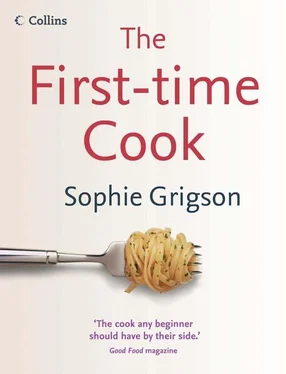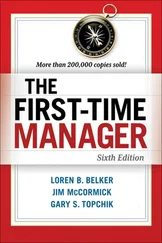Somewhere among the ingredients will usually be one that serves primarily as a thickener, to give body to the soup. Potatoes are the commonest, but rice, beans or lentils play a similar role. A few more starchy vegetables, e.g. parsnips, need no thickener, as they are quite capable of doing the job themselves.
Obviously soups need some type of liquid to dilute the main ingredients. In certain cases, where there is already a considerable depth of flavour present, water may be quite adequate. Milk can sometimes be used too. The rest of the time you really need a decent stock. This is the backbone of the soup. You can’t taste it specifically, but it is what all the other ingredients rely on for support. An insipid or tasteless stock will produce an indifferent soup. An absolutely tip-top home-made stock will transform the soup into something outstanding.
Stock-cubes and powdered ‘bouillon’ are tolerable stand-bys though not half as good as the real McCoy. Make them up slightly weaker than suggested on the packet so that the factory-brewed overtones are not so evident. You can buy real liquid stocks in supermarkets (sold in small tubs, often stacked alongside the chilled meat) and they come in second best.
By far and away the best option, however, is to make stock yourself. Whenever you have had a roast chicken, say, or find a selection of odds and ends of vegetables hanging around in your veg drawer, knock some stock up, and then freeze it for another day.
This is the ideal list of ingredients, but as long as you have the chicken carcass (most butchers will sell off raw ones cheap, and they do the best job), the onion, the carrot and one or two of the herbs, you can turn out a fine stock. Remember not to add salt to a stock. Why? Just in case you want to boil it down to concentrate the flavour, or add it to other ingredients that are already salty.
1 chicken carcass, raw or cooked
1 onion, peeled and quartered
1 carrot, peeled and quartered
1 leek, quartered
1 celery stalk, quartered
1 bay leaf
2 parsley stalks
1 thyme sprig
8 black peppercorns
1Break the chicken carcass up roughly. Put all the ingredients into the largest microwaveable bowl you own. Pour over enough boiling water to cover everything.
2Cover with a tight layer of clingfilm, and then microwave on full power for 25 minutes. Let the whole lot stand for a further 25 minutes, then strain.
1Use the same ingredients on page 15.
2Pile them into a roomy saucepan, and add enough water to cover generously. Bring up to the boil, then turn the heat down low and simmer very gently – the water should just tremble – for 3 hours, adding more hot water every now and then as the liquid level falls.
3Once cooked, strain.
The greater the variety of vegetables you add, the better balanced the taste. Avoid potatoes (which make the stock cloudy) and globe artichokes (which make the stock bitter). The sulphurous scent of over-cooked brassicas, such as cabbage, broccoli or Brussels sprouts, is not too pleasant either, so leave them out. This is a good way of using up fresh vegetable trimmings and parings, as long as the vegetables were washed.
1 onion, peeled and roughly chopped
1 carrot, peeled and roughly chopped
1 leek, roughly chopped
2 celery stalks, sliced
2 bay leaves
1 large thyme sprig
3 parsley sprigs
8 black peppercorns
whatever other vegetables you have to hand (e.g. green beans, runner beans, courgettes)
1Put all the ingredients into a saucepan and cover with water. Bring up to the boil, and simmer very gently for 30 minutes.
2Strain and chill or freeze.
STORING STOCK Stock will keep for two days in the fridge. If you want to keep it for longer than that, pour it into a wide, deep frying pan and boil down until reduced in volume by about two-thirds. Cool, and then pour carefully into ice-cube trays. Freeze, and then store your own home-made frozen stock cubes in an airtight container in the freezer. When you come to use them, melt and dilute with water to taste, to restore your stock to its original state.
If you like smooth soups, then you will need to invest in some type of liquidiser. Jug liquidisers are surprisingly cheap and make a far smoother soup than a processor, which is far more expensive anyway. Hand-held wand liquidisers are also a bargain. Although it takes longer to liquidise a saucepanful of soup, you have a greater degree of control, so that if you wish you can vary the texture from rough and chunky to silky smooth.
Before liquidising, let the soup cool a little, so that odd splashes won’t burn you. With a jug liquidiser, always make sure that the lid is firmly clamped on. Don’t over-fill – it is better to liquidise the soup in three or four batches, than to risk it squirting out all over the kitchen.
Even the toughest liquidiser can’t reduce absolutely everything to a smooth cream, so every now and then you will come across a soup that also needs sieving (such as the roast tomato and onion soup on page 24). The trick here is to make sure that you have a sieve with a comparatively loose mesh, i.e. with big enough holes to make sieving bearable. A sieve with a very tight mesh is fine for, say, sifting flour, but a nightmare when it comes to soups and sauces, as you have to work really, really hard for relatively small returns. So, go check your sieves and if necessary invest in a new, wide-meshed one as soon as possible. With that in hand, sieving a soup should be an easy enough matter. Use the largest wooden spoon you own to push the solids through the mesh of the sieve, scraping the puréed matter that clings to the underside off into the rest of the soup fairly frequently.
Alternatively, you could buy a mouli-légumes, or a food mill, which will do a similar job with efficiency.
Once your soup is liquidised, you can assess the consistency properly. You may like it just as it is, but if you want to thin it down to a lighter consistency, stir in a little water if it needs only minor adjustment, or more stock, or perhaps some milk, if appropriate. Add a little at a time, stir in and then taste. Be careful not to overdo the extra liquid, or you will end up with a soup that tastes of precious little at all.
An unadorned naked bowl of soup is a fine thing in itself, but there are times when all of us, soup included, benefit from a spot of dressing up. Some garnishes go particularly well with specific soups, whilst others are universally a good thing. Here is a list of some of the best, to be used on their own or in tandem with others
Fresh herbsShredded basil leaves on any tomato-based soup; coriander leaves on soups with a hint of spice; chopped parsley or chives will give a lift to most soups; tarragon leaves bring a hint of aniseed – use your imagination.
CreamA drizzle or swirl of cream looks classy and enriches soup. It doesn’t matter a great deal whether it is single, whipping or double cream. Lightly whipped cream, seasoned with lime juice or herbs, floats on top of the soup, melting gently in the heat. Soured cream, crème fraîche and yoghurt (especially Greek-style yoghurt) need to be dolloped on gently. Yoghurt has a tendency to sink.
Читать дальше












